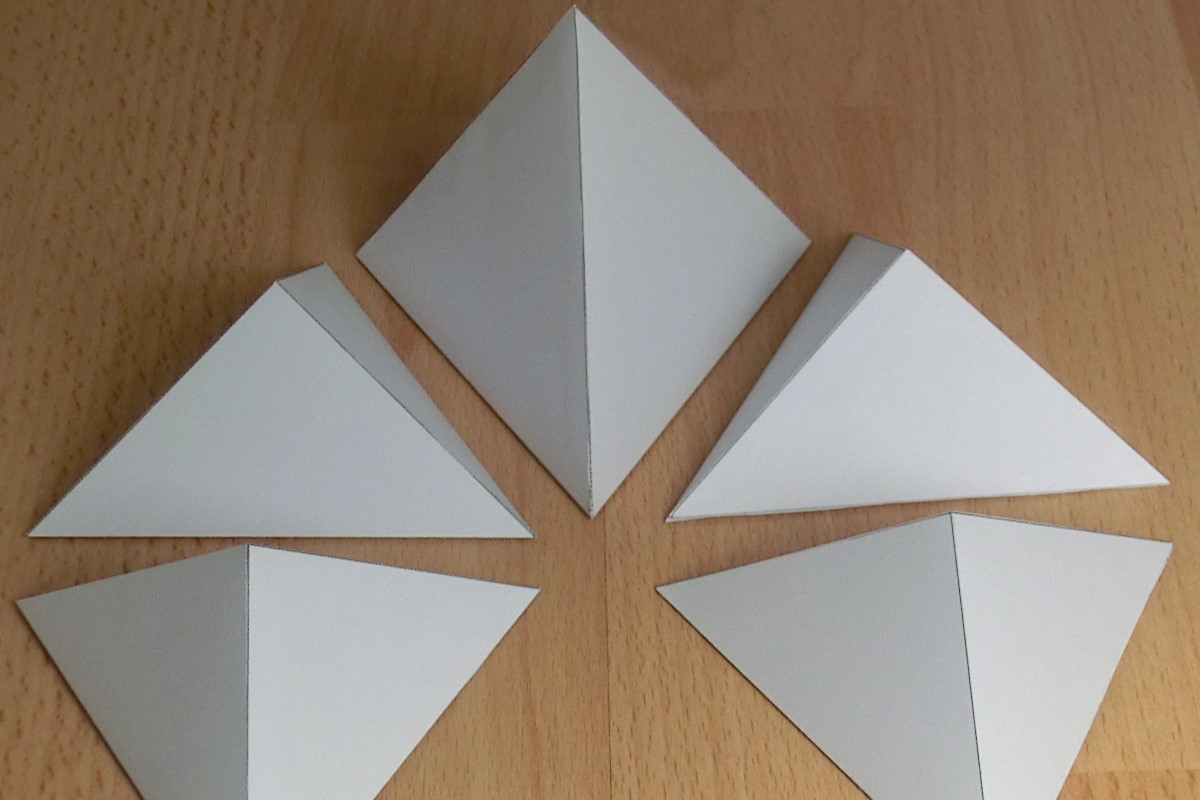Home>Education>Unlock The Secrets Of Triangular Base Pyramids: Formulas For Lateral Surface Area, Total Surface Area, And Volume Revealed!


Education
Unlock The Secrets Of Triangular Base Pyramids: Formulas For Lateral Surface Area, Total Surface Area, And Volume Revealed!
Modified: March 3, 2024
Unlock the secrets of triangular base pyramids with comprehensive formulas for lateral and total surface area, and volume. Elevate your education with these essential insights!
(Many of the links in this article redirect to a specific reviewed product. Your purchase of these products through affiliate links helps to generate commission for Noodls.com, at no extra cost. Learn more)
Table of Contents
Introduction
Welcome to the fascinating world of triangular base pyramids! These geometric wonders have captured the imagination of mathematicians, architects, and enthusiasts for centuries, and for good reason. The elegant simplicity of their form belies the complexity of their properties and the mathematical beauty they embody. In this article, we will embark on a journey to unlock the secrets of triangular base pyramids, delving into their essential formulas for lateral surface area, total surface area, and volume. By the end of our exploration, you will gain a deep understanding of these enigmatic structures and the mathematical tools to analyze and appreciate their unique characteristics.
Triangular base pyramids, with their distinctive three-sided base and sloping sides meeting at a single apex, hold a special place in the realm of geometry. Their striking appearance and structural efficiency have made them a popular choice in architecture, from ancient civilizations to modern skyscrapers. Moreover, their geometric properties have sparked the curiosity of mathematicians, leading to profound insights into spatial relationships and the interplay of shapes and dimensions.
As we venture into the world of triangular base pyramids, we will unravel the fundamental concepts that underpin their geometric nature. Through clear explanations and illustrative examples, we will demystify the formulas for calculating the lateral surface area, total surface area, and volume of these geometric marvels. Whether you are a student seeking to deepen your understanding of geometry, an educator looking for engaging teaching resources, or simply an enthusiast eager to explore the wonders of mathematics, this article will equip you with the knowledge and tools to comprehend and manipulate triangular base pyramids with confidence and insight.
So, join me as we embark on this mathematical odyssey, where we will uncover the secrets of triangular base pyramids and unveil the elegant formulas that govern their essential properties. By the end of our journey, you will emerge with a newfound appreciation for the geometric elegance and mathematical profundity of these captivating structures. Let's dive in and discover the enchanting world of triangular base pyramids together!
Understanding Triangular Base Pyramids
Triangular base pyramids are geometric solids characterized by a three-sided base and sloping triangular sides that converge at a single point, known as the apex. This distinctive structure imparts a sense of elegance and stability, making triangular base pyramids a prevalent architectural and mathematical feature throughout history.
In geometry, the base of a triangular base pyramid is a triangle, and the sides are three triangular faces that extend from the base to the apex. The base of the pyramid serves as the foundation, providing a stable platform on which the pyramid rests. The sloping sides, also known as lateral faces, ascend from the edges of the base to the apex, forming a pyramid's iconic shape. This unique configuration contributes to the pyramid's structural integrity and aesthetic appeal, making it a popular choice in architectural design and geometric exploration.
One remarkable feature of triangular base pyramids is their symmetry. The apex lies directly above the centroid of the base triangle, creating a perfect alignment that gives the pyramid a harmonious and balanced appearance. This inherent symmetry not only enhances the visual appeal of the pyramid but also reflects the geometric precision underlying its construction.
Furthermore, triangular base pyramids exhibit uniformity in their lateral faces, with each face forming an identical triangle. This uniformity contributes to the pyramid's geometric coherence, emphasizing the seamless transition from the base to the apex. As a result, triangular base pyramids embody a sense of geometric elegance and unity, captivating the imagination and inspiring mathematical inquiry.
In addition to their architectural and aesthetic significance, triangular base pyramids play a pivotal role in the study of spatial relationships and three-dimensional geometry. Their distinct shape and well-defined properties make them valuable subjects for mathematical analysis and exploration. By understanding the geometric intricacies of triangular base pyramids, mathematicians and enthusiasts gain insight into the fundamental principles of solid geometry, paving the way for deeper comprehension and innovative applications in various fields.
In the next sections, we will delve into the essential formulas for calculating the lateral surface area, total surface area, and volume of triangular base pyramids. By unraveling these formulas, we will uncover the quantitative measures that characterize the spatial and dimensional attributes of these geometric wonders, further enriching our understanding of their mathematical essence.
Formulas for Lateral Surface Area
The lateral surface area of a triangular base pyramid encompasses the total area of all its lateral or side faces. Calculating this essential measure provides valuable insights into the geometric characteristics of the pyramid, shedding light on its spatial coverage and visual representation. To derive the formula for the lateral surface area of a triangular base pyramid, we need to consider the dimensions of its lateral faces and leverage fundamental geometric principles.
Let's begin by exploring the process of calculating the lateral surface area. For a triangular base pyramid with a base perimeter denoted as P and a slant height represented by l, the lateral surface area (LA) can be expressed using the formula:
LA = (P * l) / 2
In this formula, the base perimeter P corresponds to the sum of the lengths of the three sides of the base triangle. The slant height l refers to the distance from the apex of the pyramid to the midpoint of any of its base edges. By multiplying the base perimeter P and the slant height l and then dividing the product by 2, we obtain the lateral surface area of the pyramid.
It's important to note that the slant height of a triangular base pyramid plays a crucial role in determining its lateral surface area. The slant height represents the distance along the lateral face from the apex to the base edge, forming a right-angled triangle with the height of the lateral face. This geometric relationship is fundamental to the calculation of the lateral surface area and underscores the significance of the pyramid's spatial dimensions in defining its surface characteristics.
By applying the formula for lateral surface area, mathematicians, architects, and students can quantify the extent of the pyramid's lateral coverage, facilitating precise measurements and visual representations. This quantitative measure provides valuable information for architectural design, spatial analysis, and geometric exploration, enhancing our ability to comprehend and manipulate triangular base pyramids with mathematical rigor and practical relevance.
In summary, the formula for the lateral surface area of a triangular base pyramid offers a systematic approach to quantifying the spatial coverage of its lateral faces. By leveraging the base perimeter and slant height, this formula encapsulates the geometric essence of the pyramid's lateral surface, enabling us to grasp its spatial extent and visual representation with clarity and precision. Through the application of this formula, we gain a deeper understanding of the geometric intricacies of triangular base pyramids and their profound significance in the realm of solid geometry.
Formulas for Total Surface Area
The total surface area of a triangular base pyramid encompasses the sum of its lateral surface area and the area of its base. This comprehensive measure provides a holistic view of the pyramid's spatial coverage, incorporating both its lateral and horizontal dimensions. To derive the formula for the total surface area of a triangular base pyramid, we must consider the contributions of its lateral faces and base triangle, integrating them into a unified measure of spatial extent and geometric representation.
The formula for the total surface area (TSA) of a triangular base pyramid can be expressed as the sum of its lateral surface area and the area of its base. Mathematically, the formula can be represented as:
TSA = LA + B
In this formula, LA denotes the lateral surface area of the pyramid, as previously discussed, and B represents the area of the base triangle. The base area B can be calculated using the standard formula for the area of a triangle, which involves the base length and the corresponding height. By adding the lateral surface area and the base area, we obtain the total surface area of the pyramid, capturing both its vertical and horizontal spatial coverage.
The inclusion of the base area in the formula for total surface area reflects the pyramid's three-dimensional nature, encompassing not only its lateral faces but also its foundational base. This comprehensive measure provides a complete representation of the pyramid's spatial extent, offering valuable insights into its geometric properties and visual representation. By quantifying the total surface area, mathematicians, architects, and students gain a comprehensive understanding of the pyramid's spatial coverage, enabling precise measurements and geometric analyses.
Furthermore, the formula for total surface area underscores the interconnectedness of the pyramid's geometric components, emphasizing the integration of its lateral and horizontal dimensions. This holistic approach to measuring the pyramid's surface area aligns with the multidimensional nature of solid geometry, where spatial relationships and geometric interactions are central to understanding three-dimensional shapes.
In summary, the formula for the total surface area of a triangular base pyramid consolidates the contributions of its lateral faces and base triangle, providing a unified measure of its spatial coverage. By combining the lateral surface area and the base area, this formula offers a comprehensive view of the pyramid's geometric essence, enriching our understanding of its multidimensional nature and spatial representation. Through the application of this formula, we gain a deeper appreciation for the intricate interplay of geometric elements within triangular base pyramids, illuminating their significance in the realm of solid geometry.
Formulas for Volume
The volume of a triangular base pyramid represents the amount of space enclosed within its three-dimensional structure, providing a fundamental measure of its spatial capacity. Calculating the volume of a pyramid involves leveraging its geometric properties and employing a specialized formula tailored to its distinct shape. By unraveling the formula for volume, we gain valuable insights into the pyramid's spatial magnitude and its significance in architectural, mathematical, and practical contexts.
The formula for the volume (V) of a triangular base pyramid can be expressed as:
V = (B * h) / 3
In this formula, B represents the area of the base triangle, and h denotes the height of the pyramid, which extends from the apex to the centroid of the base triangle. By multiplying the base area B and the height h and then dividing the product by 3, we obtain the volume of the pyramid. This formula encapsulates the pyramid's spatial capacity, reflecting the interplay of its base dimensions and height in defining its three-dimensional extent.
The inclusion of the base area and height in the volume formula underscores the pyramid's geometric coherence, emphasizing the integration of its foundational base and vertical dimension in quantifying its spatial volume. The base area, calculated using the standard formula for the area of a triangle, contributes to the pyramid's volumetric measure, reflecting its horizontal spatial coverage. Meanwhile, the height, extending from the apex to the centroid of the base triangle, governs the pyramid's vertical spatial extent, influencing its volumetric capacity.
By applying the formula for volume, mathematicians, architects, and students can quantify the spatial magnitude of the pyramid, enabling precise measurements and geometric analyses. The volume serves as a crucial metric for architectural design, construction planning, and spatial analysis, providing a quantitative measure of the pyramid's spatial capacity and its practical implications in real-world applications.
Furthermore, the formula for volume illuminates the pyramid's three-dimensional nature, emphasizing its spatial magnitude and the interplay of its geometric components. This quantitative measure encapsulates the pyramid's spatial essence, enriching our understanding of its volumetric properties and its significance in the realm of solid geometry.
In summary, the formula for volume offers a systematic approach to quantifying the spatial capacity of a triangular base pyramid, integrating its base area and height to define its three-dimensional extent. Through the application of this formula, we gain a deeper appreciation for the pyramid's volumetric magnitude and its profound significance in architectural, mathematical, and practical contexts.
Conclusion
In conclusion, our exploration of triangular base pyramids has unveiled the remarkable geometric properties and essential formulas that govern their lateral surface area, total surface area, and volume. Through our journey into the world of these captivating structures, we have gained a profound understanding of their spatial dimensions, geometric coherence, and practical significance in architectural, mathematical, and real-world contexts.
The elegance of triangular base pyramids lies not only in their striking visual appeal but also in the mathematical precision that underpins their form and structure. By delving into the formulas for lateral surface area, total surface area, and volume, we have uncovered the intricate relationships between the pyramid's base dimensions, height, and spatial coverage. These formulas serve as invaluable tools for quantifying and analyzing the geometric essence of triangular base pyramids, empowering mathematicians, architects, and students to comprehend and manipulate these geometric wonders with clarity and insight.
Furthermore, our exploration has highlighted the multidimensional nature of triangular base pyramids, emphasizing the interconnectedness of their lateral and horizontal dimensions. The integration of lateral surface area, total surface area, and volume encapsulates the pyramid's spatial coherence, reflecting its geometric unity and spatial magnitude. This holistic approach to measuring and quantifying the pyramid's essential properties enriches our understanding of its geometric essence and its profound significance in the realm of solid geometry.
As we conclude our journey, we emerge with a newfound appreciation for the geometric elegance and mathematical profundity of triangular base pyramids. Their enduring presence in architecture, mathematics, and geometric exploration underscores their timeless appeal and their role as symbols of spatial harmony and mathematical beauty. By unraveling the secrets of triangular base pyramids and unveiling the elegant formulas that define their essential properties, we have embarked on a mathematical odyssey that has enriched our understanding of these captivating structures and their enduring legacy in the realm of geometry.
In the end, our exploration of triangular base pyramids serves as a testament to the enduring allure of geometric wonders and their profound impact on human creativity, mathematical inquiry, and architectural innovation. May our newfound insights inspire further exploration and appreciation of the geometric marvels that enrich our world and ignite the imagination of generations to come.














